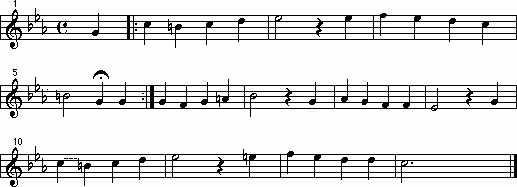Music 395—Worksheet 10
Name:
The Chorale Prelude & Vocal Polyphony
Due Date: Monday, May 3, 2004
Readings—
-
Green, Form in Tonal Music
-
Chapter 7, Theme and Variations, pp. 101-104
-
Chapter 14, Fugue and Related Genres, pp. 257-258, 282-289
-
Christ, DeLone, et al, Materials and Structures of Music
-
Chapter 6, “Cantus Firmus Techniques: The Chorale Prelude,” pp. 126-140
-
Tovey, Essays in Musical Analysis
-
New Grove Dictionary of Music and Musicians (Library Reference Collection)
-
Vol 16 (1980 edition), “Ritornello”, p. 58 (last three paragraphs)
-
Vol. 15 (1980 edition), “Point,” p. 22 (entire article, but pay special
attention to the definition of “point of imitation” (still in current usage)
towards the end)
Return to top
Score Analysis 1
Bach, “O Gott, du frommer Gott”—Burkhart, p. 126 (see p. 133 in 5th ed.)
Below is the chorale melody that Bach embellished to create the chorale
prelude “O Gott, du frommer Gott.” Make a photocopy of p. 126 (or 133 in 5/e) from Burkhart. Then compare the original chorale melody with the embellished version by
circling (on the photocopy) notes of the original melody as you follow
it through the prelude (top voice only!).

Return to top
Score Analysis 2
Bach, B minor Mass, “Et expecto resurrectionem”—Palisca, Norton Anthology of Western Music, Vol. 1, pp. 560-574 (pick up photocopy if you don’t have NAWM)
On p. 45 of his essay, Tovey reprints the ritornello melody from a cantata
movement that Bach used as the basis for this chorus. Diagram this chorus
as an example of ritornello form. First you must distinguish between ritornello
statements and episodes in this work.
Curiously, Bach never once states the ritornello in its entirety in
this chorus, so you can treat any statement of at least 8 measures from
“Tovey’s” ritornello as a ritornello statement. The only exception is a
very brief statement of the ritornello at the tail end of the chorus. Everything
else may be treated as episode. Look carefully—Bach often rearranges the
order of events in the middle of some ritornello statements. To further
confuse matters, Bach often uses fragments from the ritornello in his episodes
(just as in his fugues), especially those motives that Tovey marks as (a)
and (b).
-
NOTE—You can avoid this confusion if you apply the following “rule” (valid
only for this piece!)—all ritornello statements must be at least 8 measures
long (except the last one).
-
Hint—You should find five ritornello statements (the last one very brief)
and four intervening episodes.
Label and number each ritornello statement on your diagram (Ritornello
I, Ritornello II, etc.), and tell me (with measure numbers) which portion
of “Tovey’s” ritornello Bach used in each statement. [Ex. “Ritornello I
(m,. 17-24)”] Label episodes so as to show clear similarities or contrasts
between the episodes (i.e., if the second episode is similar to the first,
call it A’; otherwise call it B!). Under the time-line on your diagram,
indicate the measure number where each ritornello or episode begins and
name the principal key for each section.
Once you have found your ritornelli and episodes, identify (on the diagram)
those sections that are primarily for chorus, those primarily for orchestra,
and those in which chorus and orchestra both participate.
Answer these questions:
-
Does Bach use changes in scoring/instrumentation to help distinguish between ritornello and episode sections? If so, explain. How do these sections express the principles of ritornello form (as found in Baroque concertos—see pp. 234-240 in Green if you need to review)?
-
Which sections of the chorus fit the definition of “point of imitation,”
Ritornelli or episodes? Explain.
Return to top
Suggested Recordings—
Buehler Library
-
MCD N882 v.1—Palisca, Norton Recorded Anthology of Western Music, Vol. 1
- Bach, Et expecto—CD6, tracks 18-19
Created 4/28/04 by Mark Harbold—last updated 4/28/04.

